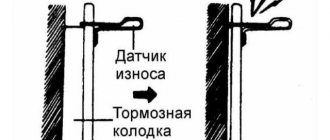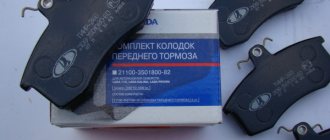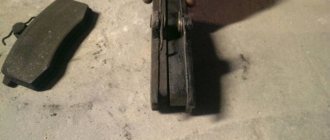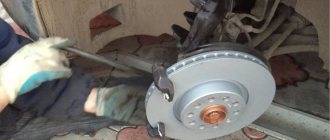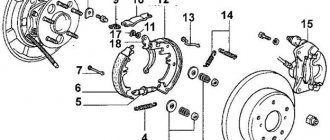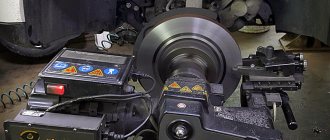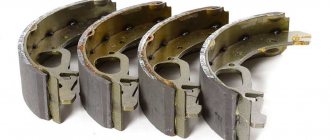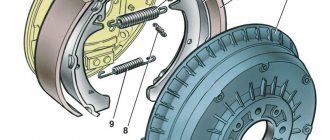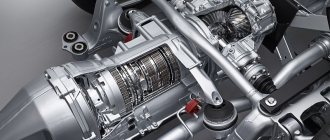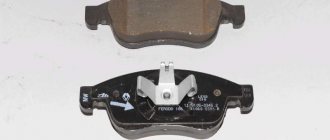The braking system is responsible for safe braking of the car. The efficiency and speed of stopping depends on its serviceability. The number of mechanisms in the brakes is quite large, and they all must work like clockwork, because the failure of one will entail at least unpleasant consequences. Let's talk about what the minimum thickness of brake pads should be, as well as ways to check for wear.
About the main types of pads
The automotive industry has come a long way in recent years. A modern car, as a rule, has an advanced braking system; this is the presence of computer-controlled systems. This should include ABS, directional stability system, etc. The constant development of cars leads to progress in the types of brake pads. The following types are distinguished:
- with a semi-metallic friction layer (65% copper, iron powder, wire);
- organic friction layer (rubber, glass, Kevlar);
- from organics and metallic inclusions in a ratio of 70/30);
- ceramic friction layer with a small inclusion of copper.
Each of the above types has its own strengths and weaknesses. For example, a semi-metallic friction layer has good heat dissipation, but it wears out quickly and makes a lot of noise during operation. But organic brake pads make virtually no noise and operate smoothly, but in the process they emit a lot of dust that settles on the wheel disc. We can safely say that ceramic ones are the most preferable. They do not make noise and do not wear out too quickly. Their only drawback is their high cost.
Why do pads wear out too quickly?
There are several obvious reasons for premature lining wear. Constant driving around the city, when you have to brake often. This leads not only to wear, but also to high temperature of the disc and pads. Many motorists prefer aggressive driving with prolonged and sharp braking. This also results in high wear rates. While a quiet ride often contributes to a long “life” of the brakes.
If you often have to drive with a loaded trunk, then this, on the contrary, helps reduce the load on the front axle and brakes, respectively. In general, it is recommended to change brake pad linings within the time limits specified by the manufacturer. For the rear axle this is usually 40,000 km, and for the front axle approximately 20,000 km. Although they can fail either earlier or later, it is better to carry out regular checks.
What is this detail?
The brake pad is a steel plate with a lining made of materials that can withstand high friction. She constantly works in unfavorable conditions. In addition to the aforementioned friction and subsequent heating, it is affected by water (which leads to a sharp temperature change) and other factors, for example, road reagents. Over time, cracks appear on the surface of the linings, their thickness decreases, and the car begins to brake worse.
When do you need to change brake pads?
In addition to the mileage of the car, manufacturers also indicate the minimum permissible thickness of the friction lining at which replacement is necessary. After all, it often happens that you have already driven 20-30 thousand km, and the pads are like new, or, on the contrary, they have driven a little, and the wear is already critical.
The weight of the car also matters. The less the car weighs, the slower the pads wear out and vice versa. But in most cases, the minimum thickness of brake pads on different brands is almost the same and is 2-3 mm.
Sometimes critical wear can be seen visually without even removing the wheel. In this case, you can stock up on a set for one axle in advance. If the corresponding icon on the dashboard lights up (this option is not available on all cars), it means that the electronic sensor that determines the minimum permissible thickness of the friction linings has been activated.
Compressibility
Modern requirements for friction materials give rise to new terms and new indicators. One of them is the compressibility of the friction lining.
The pause from the moment you press the pedal until the required braking torque occurs depends on how flexible the lining is. A soft pad can unacceptably prolong this pause, while a too hard pad will cause unwanted squeaks and squeaks when braking. We need an optimum.
Rice. 4. Sample “Block T” after bench tests using the AK-Master method
Rice. 5. Sample “Block D” after bench tests using the AK-Master method
Rice. 6. Sample “Block B” after bench tests using the AK-Master method
In addition, determining compressibility at different stages of lining manufacturing allows us to track, firstly, the stability of each link in the technological chain, and secondly, the correctness of the technical process as a whole. What did the tested pads demonstrate?
First, the good stuff. In terms of compressibility under normal conditions, all pads comply with the requirements of GOST R 41.90–99 (UNECE Rules No. 90).
However, the compressibility values for all presented samples are unstable. The largest scatter was found in the “Block B” sample – 52 µm (min 176, max 228 µm). And the smallest spread was demonstrated by the participant “Block T” - 27 microns (max 85 and min 58 microns).
Rice. 7. Appearance of the lining “Block B” after bench tests for compliance with UNECE Rules No. 13-N
About what not to do
Not every car owner regularly checks their brake system. This leads to a variety of consequences, including accidents on the road. This is still good if you crash into a tree in your yard, but what if the brakes fail on the highway? Of course, experienced motorists will use engine braking, but not everyone will have time to figure out what’s going on.
So, never allow the brake pad linings to wear down to metal. This will damage the brake disc and ultimately cause the system to fail. Check the condition of the brakes regularly. It’s not difficult to do this yourself. You shouldn’t crawl under the car every 5 thousand km, but when the time comes, don’t be lazy.
What conclusions can be drawn?
So we figured out how to determine brake pad wear. This can be done visually, or using a ruler or caliper. If you do not have the time and desire to deal with this issue yourself, then entrust this matter to the specialists at the service station.
The minimum thickness of brake pads should be 2-4 mm, but values such as 1.5 mm are allowed. If the overlay is smaller, we change it. If it is within the acceptable range, but is already suitable, we are preparing to replace it soon. It is also worth regularly checking the brake discs for wear and overheating. The latter leads to the disc warping, and the system works less efficiently - the braking distance increases and runout appears. So we figured out when the brake pads are replaced. The price for them differs depending on the manufacturer and varies between 800-3500 rubles. But you don’t need to take the cheapest “musical” friction linings.
During breaks between scheduled maintenance, the car owner must monitor the condition of the brake system. Anyone can assess the wear of brake pads and discs (drums), the main thing is not to be lazy.
LADA > Kalina
In most cars, during normal use, the inner pad wears out a little faster than the outer one, and this does not depend on the design of the brake mechanisms. However, under specific operating conditions or due to the design features of some machines, the internal pads sometimes wear out noticeably more intensively than the external ones. For example, on a second-generation Mazda 6, the inner pad on the front right wheel wears out one and a half times faster than the outer one.
In addition to design nuances, malfunctions may also occur. For example, increased pad wear due to a soured piston. Therefore, when inspecting the brakes for the first time on a car you have never driven before, it is important to remove the wheel to assess the condition of both the outer and inner pads. Unscrupulous servicemen often limit themselves to an approximate assessment of the wear of only the outer pads, examining them through the spokes of the wheel rim, without removing the wheel itself. It is possible that soon a dissatisfied customer will return to this service station with worn out internal pads and complaints!
As an example, let's check the condition of the brakes on the editorial Kalina, which has driven almost 63,000 km. In addition, we provide approximate indicators for critical wear of various elements of the brake system. For each specific car model, they may differ either up or down. This data can be found in repair and maintenance books or on the Internet.
But let's return to our Kalina. Only after removing the wheel is the real picture visible. The thickness of the friction lining is approximately equal to the thickness of the pad base: wear is about 60%. If the thickness of the friction lining decreases to 2 mm, this will mean 100% wear. Many cars have a metal tongue at the base of the block. When the lining wears critically, it begins to come into contact with the brake disc, producing a characteristic squeak. Most often, the tongue is installed only on the inner pads.
Compliance with UNECE Regulation No. 13
Next, bench tests were carried out for compliance with UNECE Regulations No. 13. The original linings 2110–3501090 were used as an analogue, the samples were taken from the serial batch. And this is what turned out.
The indicators closest to the analogue were obtained from the “Block B” sample. The braking efficiency of the other two samples was on average 25% lower than that of the analogue. Despite the fact that the standard of deviation from the original according to UNECE Rules No. 13 is 15%.
All samples showed satisfactory results in the loss of efficiency test. For the “Block B” linings, insufficient recoverability of frictional properties was noted, amounting to 80% of the original level.
The recoverability of the friction properties of the “Block D” linings is 90%, and the “Block T” linings are 130%, which indicates significant over-recoverability and instability of the friction properties of the blocks.
After completion of the tests, inspection of the products revealed that the “Block B” linings were unsuitable for use due to significant (more than 5 mm) detachments of the lining from the frame on the outer block. The appearance of these pads is shown in Fig. 7.
For the “Block D” samples, one transverse crack and chipping of the edge were noted on each of the linings (Fig. 8).
Individual short surface cracks are noted on the “T-block” overlays (see Fig. 9). Also, when the brakes were heated to a temperature of more than 450 °C, the linings ignited.
At the end of the chapter there is a disappointing conclusion. Based on the results obtained, all samples of pads were found unsuitable for use in the brake mechanisms of VAZ 2108–2110 vehicles:
• “Block B” – due to delamination of the lining from the frame;
• “Block T” – due to ignition during testing;
• “Block D” – due to destruction and delamination of the lining.
Why might pad wear accelerate?
It is important to remember about difficult operating conditions, for example, driving along mountain serpentines or participating in amateur racing. In such modes, in a working brake system, the inner pad may begin to wear down many times faster than the outer one. Something similar once happened to my car. During everyday driving, the pads on the latest generation Volkswagen Jetta sedan wore evenly. This lulled my vigilance, and I stopped monitoring the condition of the internal linings. After participating in two stages of sprints (far from the most difficult for equipment), it turned out that the internal pads were almost completely worn out. This was especially noticeable on the left wheel. I was lucky that it didn’t come to the point of scuffing the brake discs!
Also, do not forget that if, for example, you drove 30,000 km and the wear of the front pads was about 50%, this does not mean that they will last up to 60,000 km. The smaller the thickness of the lining, the faster its further wear occurs. After all, the same portions of thermal energy from friction are absorbed by a less “fat” brake pad.
Test methods
The actual chemical composition of cast iron brake pads for cars and locomotives is determined according to GOST 22536.0 and a number of other interstate standards.
To assess the correct execution of the mating points of the hole for the bracket and the fit of the shoe to the back, templates are used - pass-through and a rectangular prism. Control of contact of the reference sample is carried out using probes. Linear defects are measured with a standard caliper.
The strength test of the backrest is carried out under pressure - the finished product is subjected to a force of 30 tf (300 kN). Under a load of 30 kN, with a ten-millimeter ball, find the hardness (on the Brinell scale) - according to GOST standards 27208, 9012, 23677.
To determine the microstructure, one should be guided by the provisions of interstate standard 3443. The actual mass can be calculated with an error of ± 0.2 kg.
Brake disc wear
Brake disc wear is more stable and predictable. Most often, there are enough discs for two sets of pads. A reduction in disc thickness of approximately 2 mm means 100% wear. Over time, wear causes a chamfer to form on the edge of the brake disc.
The design of many wheel rims allows you to stick your hand between the spokes and feel the wear of the brake disc by touch. The main thing is not to do this while the brake disc is still hot, immediately after a trip with intense braking. This technique will be useful for those who plan to purchase a used car. Based on disc wear, one can draw conclusions about the actual mileage of the car or the conditions in which it had to drive. But it is best to remove the wheel and carefully inspect the brake mechanism, including the inside of the disc. It happens that it is there that grooves and a wavy surface are formed due to corrosion.
Results of laboratory testing
In terms of final pad wear, the most wear-resistant products were Bosch (1.7%) and Trans Master (1.5%). And the most “weary” ones, as strange as it may seem, were the leaders of the testing ATE (2.7% - with a VAZ disk and 5.7% - with a native one) and QH (2.9% - with a native one, but 4.0 % - with VAZ).
According to laboratory tests, the best pads can be called products from the ATE and QH brands, which fully comply with the main selection criterion - quality-price ratio
At the same time, we cannot ignore the fact that the ATE pads performed better with the VAZ disc, and the QH pads with the original disc. Best, Trans Master, Rona, Roulunds and STS declared stable quality of a good level
EZATI, VATI, and to some extent DAfmi and Lucas produced good overall results. The Polyhedron and AP Lockheed brand pads were simply disappointing.
When to change brake discs and pads?
If the wear of the discs is already critical, and the pads are almost new, then do not rush to immediately change the entire set of consumables, especially if you operate the car in conditions that are not difficult for equipment. The work of replacing disks can be postponed for a while. But you shouldn’t completely turn a blind eye to the problem. Remember that as the thickness of the discs decreases, braking efficiency decreases. After all, a too thin disk will dissipate thermal energy, which will also overheat faster. In particularly advanced cases, due to excessive wear of the brake disc, the pad may even fall out of the mechanism!
With the wear of rear disc mechanisms, the situation is similar, with only one amendment: they are less loaded, and therefore wear occurs more slowly. This has both its pros and cons. Rear brake discs and pads have a longer service life compared to the front ones (about one and a half to two times), but they also suffer more from corrosion. Therefore, it is on the rear brakes that it is important to check the inner surfaces of the discs! Our Kalina has drum-type rear brakes.
Epilogue
Of course, we have not retold and quoted everything. But the most important information was conveyed to the reader. A pad that breaks or ignites when braking! Do I need to explain what this means for drivers and pedestrians?
Why don't we name the manufacturers of these pads? Yes, because such “gentlemen of fortune” are very difficult to catch by the hand. They always have in stock a batch of samples made more conscientiously. And they are ready to present them if a claim arises - for example, in an insurance case. And by that time it will be impossible to find the defective batch.
There is only one way out - to know the market well, manufacturers of original products, conveyor and aftermarket suppliers. This is open information. Conscientious manufacturers always ensure quality – even at the expense of profits. A crisis is a crisis, and security is security. And the honor of a trademark is not an empty phrase for them.
But, as we see, there are others for whom the main thing is profit. Making pads cheaper and selling them at a higher price is not a matter of quality. And what do they mean by the health and lives of drivers, passengers and pedestrians? In fact, they invite us to play “Russian roulette” - spin the revolver drum and pull the trigger. And then depending on your luck. If you are unlucky, the god, whose name is the Golden Taurus, will forgive you.
Georgy Bobrov
How to assess the wear of drum brakes?
Most machines have an inspection window on the side of the drum casing to assess the thickness of the linings. However, most often it can only be used if the car is hung on a lift or standing on a viewing hole. Otherwise, it is extremely difficult to see anything through this window.
Removing the drums is sometimes also very problematic. For example, for cars of French brands you will have to unscrew the hub nut. In the case of Kalina, everything is simple; the drums can be removed without any problems.
Typically, drum wear is assessed by the internal diameter: its increase by 1 mm means a death sentence.
What should be the thickness of brake pads?
A clear sign indicating that the pads are running out of service life is the appearance of a characteristic whistle when the car is braking - every time you press the pedal you will hear an unpleasant noise, similar to glass rubbing against metal.
If such a symptom appears, it is recommended to diagnose the brake system as soon as possible - remember, operating a car with faulty brakes negatively affects the safety of the driver and passengers.
| Characteristic | Wheel Bridge | Minimum thickness, mm |
| Disc diameter, mm | Front | 256 |
| Rear | 238 | |
| Structure thickness, mm | Front | 12 |
| Rear | 12 | |
| Possible runout, mm | Front | 0,07 |
| Rear | 0,07 | |
| Thickness of the brake lining together with the pad body, mm | Front | 18 |
| Rear | 18 | |
| Minimum permissible thickness of the lining together with the block body, mm | Front | 6 |
| Rear | 6 | |
| Minimum permissible disk thickness, mm | Front | 10.6 |
| Rear | 10.6 |
It is also important to remember that these indicators may differ if the car has a power unit with a capacity of more than 125 horsepower or a total volume of working chambers of 2.0 liters or more. In this case, it is necessary to check the thickness level of the system components after first reading the data from the vehicle’s service book.
ATTENTION! A completely simple way to reduce fuel consumption has been found! Don't believe me? An auto mechanic with 15 years of experience also didn’t believe it until he tried it. And now he saves 35,000 rubles a year on gasoline! Read more"
Note! On average, front and rear brake pads, regardless of the design of the system, wear out at different rates. This is explained by the difference in the applied dynamic force on the braking system - the front axle of the car experiences more pressure during a forced reduction in speed.
Recommendations for selection
Rule one and very important: you cannot change the front or rear brake pads one by one. It is necessary to install a set of new elements on the front or rear axle, otherwise when braking the car may seriously drift to the side
Even when one pad is worn out, all four must be replaced. As a temporary option, it is possible to install 2 new parts on one rear wheel.
When choosing new pads in the store, use the following recommendations:
- Products must match the car model and be sold in high-quality packaging with included instructions. The inscriptions on the box are clear and without errors indicating Chinese origin.
- Make sure that the friction material is the same color, without foreign inclusions.
- The surface pressed against the plane of the disk must be flat. Small chips along the edges and depressions are allowed if they occupy no more than 1% of the total area of the working plane.
- Cracks at the interface between metal and friction material are unacceptable.
Ideally, you should buy original products in original packaging. This will save you from unpleasant surprises, unscheduled replacements and emergency situations when operating your car.
How to determine pad wear at home
For self-diagnosis, you will need no more than 15 minutes, as well as the presence of a jack, a wheel wrench, and a ruler or caliper.
The entire procedure is performed as follows:
- We lift the required part of the car using a jack, and then remove the wheel to provide access to the brake mechanism;
- Next, use a measuring tool to check the thickness of the bracket in the special window on the brake mechanism. If the thickness of the brake linings does not meet the acceptable level, the parts will have to be replaced;
- Then, using the same method, we measure the thickness of the brake disc - if the indicator is insufficient, the part must also be replaced.
The thickness of the rear axle brake system is measured along with the base on which the friction lining is mounted. To provide access to the parts, in addition to the wheel, you will also have to dismantle the drum mechanism. Also at this stage, it would be reasonable to check the diameter of the working surface of the drum - if it is larger than permissible, it is also recommended to replace the structure.
Note! It is recommended to replace the brakes comprehensively, that is, in pairs on the wheel axle - otherwise there is a possibility of uneven operation of the braking system, which will lead to destabilization of the vehicle on the road during a decrease in speed.
Also, after servicing, it is recommended to undergo a short run-in within 100-150 km so that the friction layer of the components gets used.
Connection strength
Perhaps the following formulation will be clearer for the reader: checking the strength of the connection between the friction lining and the frame - the metal plate on which this lining is attached.
The bottom line is this: the lining is loaded with a force directed along the radius of the brake disc. Sooner or later, the lining is separated from the frame or the friction material is destroyed “by mass”.
It turned out that in terms of the shear resistance of the lining, all tested pads meet the requirements of two regulatory documents.
Firstly, this is GOST R 41.90–99 (UNECE Regulation No. 90) “Uniform provisions concerning the approval of replacement brake lining assemblies and drum brake linings for motor vehicles and their trailers.”
Secondly, TU 38.114499–96 “Asbestos-free linings with pads assemblies for disc brakes of VAZ 2110 and 2123 vehicles and their modifications.”
The highest shear resistance of the lining was demonstrated by the “Block T” samples. However, after bench tests, the value of the separation index decreased almost by half. The nature of the separation has also changed - 15–40% of the “bare” surface remains on the pad frame with the absence of glue, which does not meet the standards (see Fig. 1).
The most stable value of the indicator “Shear resistance of the lining relative to the block” is found in the “Block D” linings. The nature of the separation of these products is as follows: 100% “by mass” before bench tests and 10–15% “by frame” after them, which corresponds to the norm (Fig. 2).
But the most unstable value of the shear resistance indicator is found in the linings of the participant “Block B”. The difference is about 25% before bench tests and about 45% after them. At the same time, the value of the indicator decreases by 40%. And for one of the linings it is 2.6 MPa, which does not meet the requirements of the specifications and indicates the instability of the production process of these linings.
In terms of the nature of the separation, these pads also have unstable indicators: on the frames there remains from 0 to 25% of the “bare” surface without glue and friction material (see Fig. 3).
